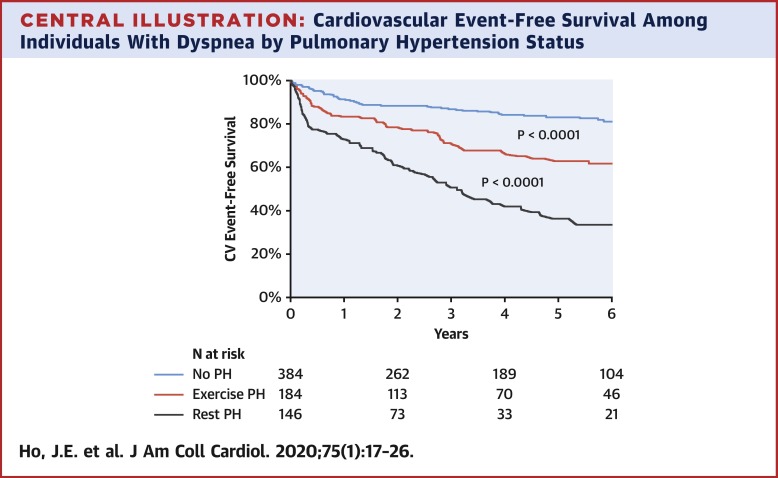当前位置:
X-MOL 学术
›
J. Am. Coll. Cardiol.
›
论文详情
Our official English website, www.x-mol.net, welcomes your
feedback! (Note: you will need to create a separate account there.)
Exercise Pulmonary Hypertension Predicts Clinical Outcomes in Patients With Dyspnea on Effort
Journal of the American College of Cardiology ( IF 21.7 ) Pub Date : 2020-01-01 , DOI: 10.1016/j.jacc.2019.10.048 Jennifer E Ho 1 , Emily K Zern 2 , Emily S Lau 2 , Luke Wooster 2 , Cole S Bailey 2 , Thomas Cunningham 2 , Aaron S Eisman 2 , Kathryn M Hardin 2 , Robyn Farrell 2 , John A Sbarbaro 2 , Mark W Schoenike 2 , Nicholas E Houstis 2 , Aaron L Baggish 2 , Ravi V Shah 2 , Matthew Nayor 2 , Rajeev Malhotra 1 , Gregory D Lewis 3
Journal of the American College of Cardiology ( IF 21.7 ) Pub Date : 2020-01-01 , DOI: 10.1016/j.jacc.2019.10.048 Jennifer E Ho 1 , Emily K Zern 2 , Emily S Lau 2 , Luke Wooster 2 , Cole S Bailey 2 , Thomas Cunningham 2 , Aaron S Eisman 2 , Kathryn M Hardin 2 , Robyn Farrell 2 , John A Sbarbaro 2 , Mark W Schoenike 2 , Nicholas E Houstis 2 , Aaron L Baggish 2 , Ravi V Shah 2 , Matthew Nayor 2 , Rajeev Malhotra 1 , Gregory D Lewis 3
Affiliation

|
BACKGROUND
Abnormal pulmonary arterial pressure (PAP) responses to exercise have been described in select individuals; however, clinical and prognostic implications of exercise pulmonary hypertension (exPH) among broader samples remains unclear. OBJECTIVES
This study sought to investigate the association of exPH with clinical determinants and outcomes. METHODS
The authors studied individuals with chronic exertional dyspnea and preserved ejection fraction who underwent cardiopulmonary exercise testing with invasive hemodynamic monitoring. Exercise pulmonary hypertension was ascertained using minute-by-minute PAP and cardiac output (CO) measurements to calculate a PAP/CO slope, and exPH defined as a PAP/CO slope >3 mm Hg/l/min. The primary outcome was cardiovascular (CV) hospitalization or all-cause mortality. RESULTS
Among 714 individuals (age 57 years, 59% women), 296 (41%) had abnormal PAP/CO slopes. Over a mean follow-up of 3.7 ± 2.9 years, there were 208 CV or death events. Individuals with abnormal PAP/CO slope had a 2-fold increased hazard of future CV or death event (multivariable-adjusted hazard ratio: 2.03; 95% confidence interval: 1.48 to 2.78; p < 0.001). The association of abnormal PAP/CO slope with outcomes remained significant after excluding rest PH (n = 146, hazard ratio: 1.75; 95% confidence interval: 1.21 to 2.54; p = 0.003). Both pre- and post-capillary contributions to exPH independently predicted adverse events (p < 0.001 for both). CONCLUSIONS
Exercise pulmonary hypertension is independently associated with CV event-free survival among individuals undergoing evaluation of chronic dyspnea. These findings suggest incremental value of exercise hemodynamic assessment to resting measurements alone in characterizing the burden of PH in individuals with dyspnea. Whether PH and PH subtypes unmasked by exercise can be used to guide targeted therapeutic interventions requires further investigation.
中文翻译:

运动性肺动脉高压可预测呼吸困难患者的临床结果
背景 某些个体对运动的肺动脉压 (PAP) 反应异常。然而,运动性肺动脉高压(exPH)在更广泛的样本中的临床和预后影响仍不清楚。目的 本研究旨在调查 exPH 与临床决定因素和结果的关联。方法 作者研究了患有慢性劳力性呼吸困难和射血分数保留的个体,他们接受了有创血流动力学监测的心肺运动测试。使用每分钟 PAP 和心输出量 (CO) 测量来确定运动性肺动脉高压,以计算 PAP/CO 斜率,并将 exPH 定义为 PAP/CO 斜率 >3 mm Hg/l/min。主要结局是心血管(CV)住院或全因死亡率。结果 在 714 人(年龄 57 岁,59% 女性)中,296 人(41%)的 PAP/CO 斜率异常。在平均 3.7 ± 2.9 年的随访中,发生了 208 起心血管或死亡事件。PAP/CO 斜率异常的个体未来发生 CV 或死亡事件的风险增加 2 倍(多变量调整风险比:2.03;95% 置信区间:1.48 至 2.78;p < 0.001)。排除静息 PH 后,异常 PAP/CO 斜率与结果之间的关联仍然显着(n = 146,风险比:1.75;95% 置信区间:1.21 至 2.54;p = 0.003)。毛细血管前和毛细血管后对 exPH 的贡献均独立预测不良事件(两者均 p < 0.001)。结论 在接受慢性呼吸困难评估的个体中,运动性肺动脉高压与无心血管事件生存期独立相关。这些发现表明,在描述呼吸困难个体的 PH 负担方面,运动血流动力学评估相对于单独的静息测量具有增量价值。运动揭示的 PH 和 PH 亚型是否可用于指导有针对性的治疗干预措施需要进一步研究。
更新日期:2020-01-01
中文翻译:

运动性肺动脉高压可预测呼吸困难患者的临床结果
背景 某些个体对运动的肺动脉压 (PAP) 反应异常。然而,运动性肺动脉高压(exPH)在更广泛的样本中的临床和预后影响仍不清楚。目的 本研究旨在调查 exPH 与临床决定因素和结果的关联。方法 作者研究了患有慢性劳力性呼吸困难和射血分数保留的个体,他们接受了有创血流动力学监测的心肺运动测试。使用每分钟 PAP 和心输出量 (CO) 测量来确定运动性肺动脉高压,以计算 PAP/CO 斜率,并将 exPH 定义为 PAP/CO 斜率 >3 mm Hg/l/min。主要结局是心血管(CV)住院或全因死亡率。结果 在 714 人(年龄 57 岁,59% 女性)中,296 人(41%)的 PAP/CO 斜率异常。在平均 3.7 ± 2.9 年的随访中,发生了 208 起心血管或死亡事件。PAP/CO 斜率异常的个体未来发生 CV 或死亡事件的风险增加 2 倍(多变量调整风险比:2.03;95% 置信区间:1.48 至 2.78;p < 0.001)。排除静息 PH 后,异常 PAP/CO 斜率与结果之间的关联仍然显着(n = 146,风险比:1.75;95% 置信区间:1.21 至 2.54;p = 0.003)。毛细血管前和毛细血管后对 exPH 的贡献均独立预测不良事件(两者均 p < 0.001)。结论 在接受慢性呼吸困难评估的个体中,运动性肺动脉高压与无心血管事件生存期独立相关。这些发现表明,在描述呼吸困难个体的 PH 负担方面,运动血流动力学评估相对于单独的静息测量具有增量价值。运动揭示的 PH 和 PH 亚型是否可用于指导有针对性的治疗干预措施需要进一步研究。











































 京公网安备 11010802027423号
京公网安备 11010802027423号